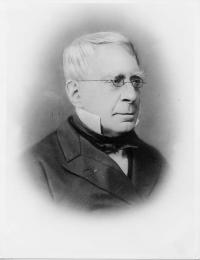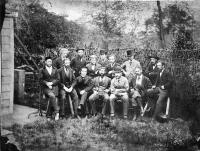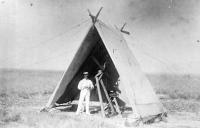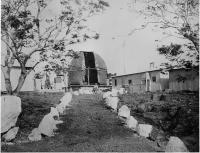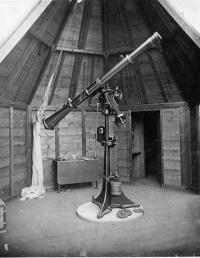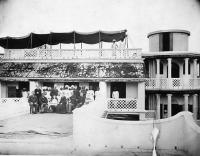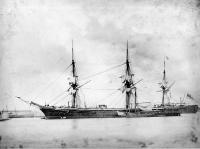About the Library & the archives
Transits of Venus, 1874 & 1882
Transits of Venus occur in pairs separated by ca. 8 years, rather less often than every century. Although now largely of only curiosity value, transits of Venus were originally crucial in determining the solar parallax (and hence the scale of the solar system), as described by Halley.
The first recorded successful observation of a transit of Venus was by the remarkable English clergyman-astronomer Jeremiah Horrocks (ca. 1619-1641), based on his own prediction that a transit would occur on 4th December 1639 (24th November 1639, Old Style). He kept a close watch from 9am until noon, and made intermittent observations between noon and 1pm. He was otherwise engaged between 1pm and 3.15pm by "business of the highest importance which, for these ornamental pursuits, I could not with propriety neglect" (his clerical duties), returning to find that the transit was in progress.
Concerted efforts were subsequently made to observe the 1761/1769 and 1874/1882 transits. This page of historical images relating to the 1874 and 1882 events was put together from materials in the RAS Library, prompted by interest in the 2004 and 2012 events.
Sir George Airy, Astronomer Royal, 1835 - 1881, was a prime mover in the British and international efforts to observe the nineteenth century Transits of Venus and in inducing his masters at the Admiralty to send Naval expeditions to transport expeditions to remote places. (RAS ADD MS 94/58) | A group of the observers for the British expeditions to the 1874 Transit are photographed, probably in Greenwich Park, as they assemble with the instruments which are tested before packing for shipment. The gentleman in mutton-chop whiskers and smoking cap, centre front row, is Captain (later Colonel) Tupman, Royal Marines Artillery, who effectively acted as Assistant Director of the British transit effort under Airy, while to his right (viewer's left) is Father Stephen Perry, SJ, of Stonyhurst College, who was in charge of the expeditions to Kerguelen Island (1874) and Madagascar (1882). (RAS ADD MS 96, p. 1) | Commander Pelham Aldrich, Royal Navy, the Captain of the survey vessel HMS Fawn, prepares to observe the 1882 Transit from an improvised tent observatory in Madagascar. This officer was a significant participant in various explorations including the oceanographic circumnavigation of HMS Challenger and an Arctic expedition under Captain Nares. This image has only recently been identified by comparison with crew photographs. It well illustrates the active part played by officers and men of the Fleet in the expeditions whose personnel and instruments their ships transported. (RAS ADD MS 209, p 21 [middle]) | ||
James Ludovic Lindsay, Lord Lindsay of Balcarres (later 26th Earl of Crawford), was a rich and enthusiastic amateur astronomer who was later to re-found the Royal Observatory Edinburgh with the gift of his instruments and Library. He mounted a private expedition to the island of Mauritius for the 1874 Transit, including significantly his expert observer Mr (later Sir David) Gill. This image shows the elaborate temporary observatory erected there. The figure in the centre is probably His Lordship. (RAS MS DREYER 7, p. 37) |
| There was widespread public interest in the Transits in many countries. Many articles and a few books were published, and lectures given, both in prospect and retrospect, by such proponents as R A Proctor and Father Perry. Here a group including both Indians and Europeans gathers to observe the 1882 event in Dava Gardens, Vizagapatam, India. (RAS ADD MS 93 / 117) | ||
| Major units of the Royal Navy were involved in both the eighteenth and nineteenth century Transit operations. The first voyage of Captain Cook included observation of a Transit from Tahiti. All the major Naval powers mounted expeditions to observe nineteenth century Transits and this took place at an interesting stage in Naval history, roughly half way through the transition from the purely sailing 'wooden walls' of the Napoleonic period to the fully steam powered fleet of the early twentieth century. This is the large steam and sail vessel HMS Volage, which transported the British expedition to the desolate and then uninhabited Kerguelen Island, in the southern Indian Ocean. (RAS ADD MS 96, p. 35) | |||
Peter Hingley. All images © Copyright 2003 Royal Astronomical Society



